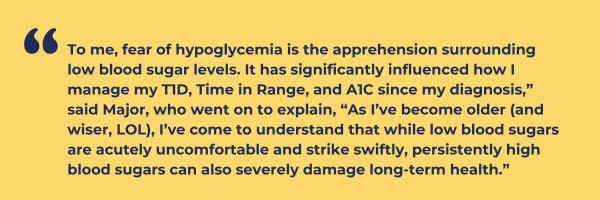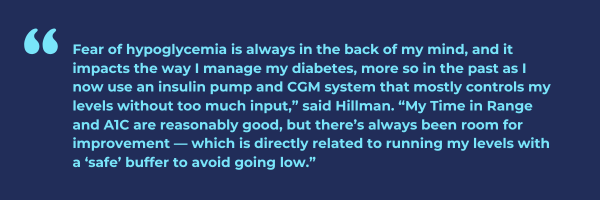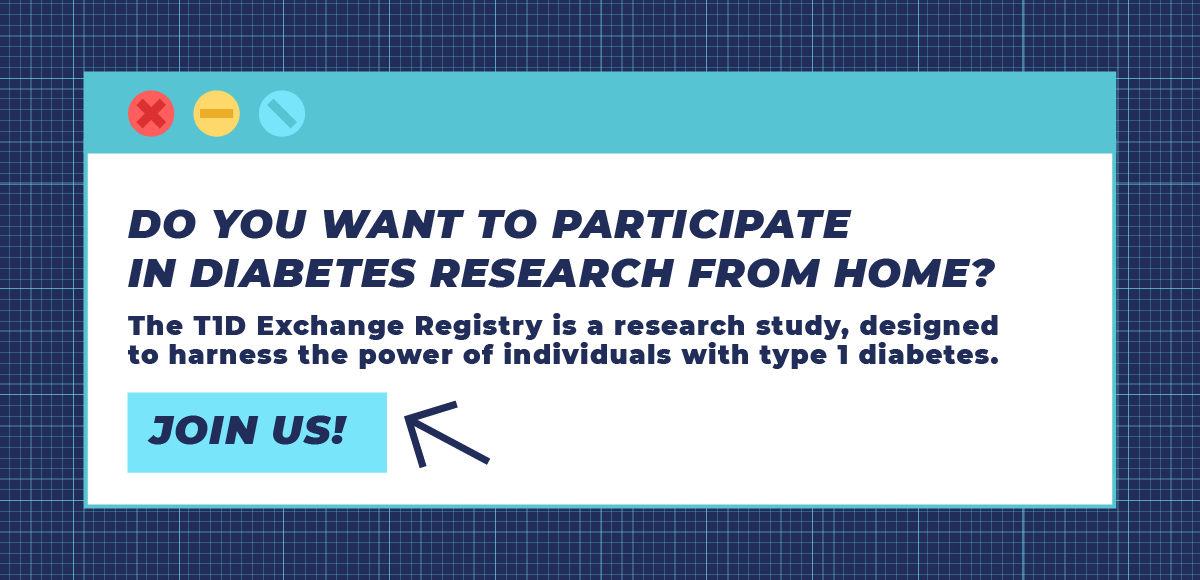
Sign up for a new account.
And get access to
The latest T1D content
Research that matters
Our daily questions
Sign up by entering your info below.
Reset Your Password
Don't worry.
We will email you instructions to reset your
password.
Lily Hillman, a 21-year-old Australian, explained how hypoglycemic worries hover in the back of her mind and, consequently, partly impact the way she manages her type 1 diabetes (T1D).
Fear of hypoglycemia (FOH) — or worry surrounding low glucose levels — can have significant impacts on daily life. What’s more, it’s not only experienced by the person living with T1D, but also those who love and support them.
“My time in range and A1C are reasonably good, but there’s always room for improvement — which is directly related to running my levels with a ‘safe’ buffer to avoid going low,” explained Hillman, who has lived with T1D since she was six.
“During my teenage and early adulthood years, I preferred my blood sugar levels on the higher side,” said Jordan Major from Gainesville, Florida. “During those transitional years of my life, high blood sugars seemed to have less disruptive effects than the rapid and severe consequences of low blood sugars.”
Put another way, to avoid hypoglycemia, both Hillman and Major have compensated, at times, by intentionally keeping their glucose on the higher side of normal. They’re not alone. Let’s take a closer look at FOH and its possible effects on the lives of everyone affected by T1D.
Fear of hypoglycemia
Fear of hypoglycemia can affect anyone whose life is touched by diabetes — and it may be an underestimated issue, according to research. For this reason, it’s important for providers to assess and understand FOH because the level at which it’s experienced can sway management decisions and impact overall health with T1D.
Let’s be real here. When managing a minute-by-minute condition with insulin, a drug that’s lifesaving — but can also be life-taking — it’s arguably impossible not to have some degree of FOH. Moreover, having a healthy amount of hypoglycemic worry can be a good and normal response to everyday life with T1D. It’s nothing to be ashamed of.
But while fear can instill action, it can also be a source of paralyzing anxiety and worry. Which can, over the long run, affect quality of life factors and diabetes-related outcomes.
With T1D, you may find yourself avoiding quiet spaces, such as a yoga class — where your continuous glucose monitor (CGM) or insulin pump may blare with “low” beeps and whistles. On the flip side, FOH can be pervasive, impacting and disrupting areas of life such as driving, attending school or work, traveling, and participating in group activities or athletic pursuits.
“Is there any person with T1D who hasn’t experienced fear of a hypo?” asked Major, who was diagnosed with T1D when she was seven. “I fear it often, but what stands out most is when I’m out by myself (no partner, friend, or other adult who knows I have T1D) with my children, who are four and two. I usually carry low snacks with me — but sometimes I forget.”
What is FOH from a T1D perspective?



Does being “hypo-ready” help?
As someone living with T1D and as a parent of a child diagnosed as a 5-year-old, I can attest to the palpable worry on both sides. Prior to CGMs and other tech advancements, a heightened sense of FOH amounted to years of burdensome stress and disrupted sleep.
I’ve learned to combat FOH through preparedness. By this, I mean being aware of my glucose and its trending, in addition to carrying rapid-acting carbs and glucagon — depending on the activity or life circumstance.
Do I exit the Grand Canyon after a long hike with extra food in my backpack? Yes. Do I have glucagon in the saddle bag on my bike? Always. Do I still get nervous about hypoglycemia when I’m adventuring outdoors? Of course — but even more so when I’m ill-prepared.
This may sound like simple logic, but being prepared can help dampen worries.
Major agrees, “Planning ahead is another critical strategy,” she said. “By always being prepared for potential hypoglycemic events and carrying snacks or glucose tabs — and having a meal plan in place — not only alleviates anxiety but ensures that you or a loved one can quickly respond to sudden drops in blood sugar levels.”
Major’s tip for T1D moms: “I keep a handful of Welch’s gummy packages in all of my bags. When I feel a low coming, I offer a pack to both of my children and eat one with them.”
How can tech make a difference?
As tech has improved with CGMs and real-time data sharing, along with interactive automated insulin delivery (AID) devices, it’s helped to lighten the mental burden and worries related to T1D. With AID system adjustments, people are experiencing improvements with Time in Range while averting dangerous hypoglycemic events.
Having said that, low glucose is still a part of every life with T1D. Everyone’s situation is unique with T1D, and a person’s FOH response can wax and wane. That’s why I like to think of FOH on a continuum or spectrum.
While tech has given many the headspace to take a deeper breath, it hasn’t erased FOH and the behaviors that accompany it. “My daily life is impacted drastically,” said Hillman. “When I graduated high school, it was a stressful time to get through exams uninterrupted. It was difficult because I was terrified of hypos and often ran high, which impacted my concentration anyhow.”
Here’s what we all know: Managing T1D is complicated. There are so many nuances surrounding glycemia, and each and every day has its differences. When low glucose hits, it can be from a storm of different factors.
We’re in a constant state of adapting and adjusting to avoid hyper and hypoglycemia. For some, normal and expected levels of FOH can even morph into irrational fears.
This intense worry may lead people to avoid certain events — and may drive them to set glucose goals higher, treat glucose levels in the normal range, underdose or skip insulin, or purposefully keep glucose levels in a higher range.
“Living with T1D is a physical, emotional, and spiritual journey that requires immense resilience and self-compassion,” said Major. “I’ve started to change the narrative around how I talk to myself about my management. Instead of, ‘I’m trying’ I rephrase to say, ‘I’m doing.’ It has made a tremendous difference in how I view my approach to life with T1D, and I’m able to give myself kudos more frequently.”
How do I get a handle on FOH?
Decreasing FOH may take a multi-pronged approach, including the following:
- Understanding how to treat hypoglycemia and adjust ratios for prevention
- Having a plan of action in place (including an educated support team)
- Preparing for emergency lows (having rapid-acting carbs on hard and unexpired glucagon)
- Embracing technology (CGM and AID systems)
- Seeking support from your diabetes care team
“Through working with my care team, discussions with T1D peers, and trial and error — I’ve developed more effective strategies to maintain my blood sugar within a safe range — balancing between avoiding dangerously low levels and preventing excessive highs. This has been a constant challenge, even with the advancements in closed-loop technology systems,” explained Major.
“Although my Time in Range and A1C levels have significantly improved compared to my adolescent, teenage, and young adult years, the fear of experiencing a hypoglycemic episode still triggers frequent alarms in my mind throughout the day,” said Major. “This ongoing concern is a reminder of the delicate balance required in diabetes management and the profound impact that fear of hypoglycemia has had on my approach to controlling my T1D.”
Jewels Doskicz
Related Stories
2 Comments
Living With T1D and Fear of Hypoglycemia: Stories From Our Community Cancel reply
You must be logged in to post a comment.








Keyboard Tester is a best tool for testing your keyboard online without downloading any software. This test is quick and so useful.
https://www.keyboardtesters.com/
The platform remains vibrant with regular updates and promotional events. just visit website, whether your preference lies in strategic card games or live poker, 3 patti bingo Game promises an engaging and rewarding experience akin to the popular card Game and 3pattibingo.